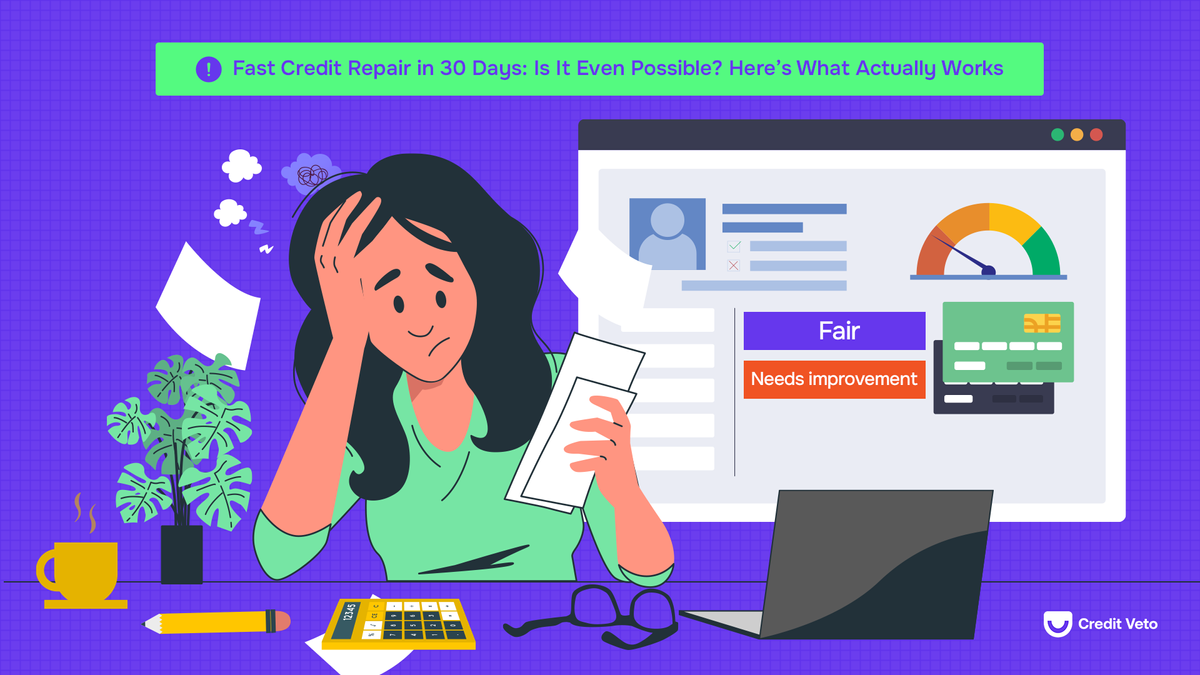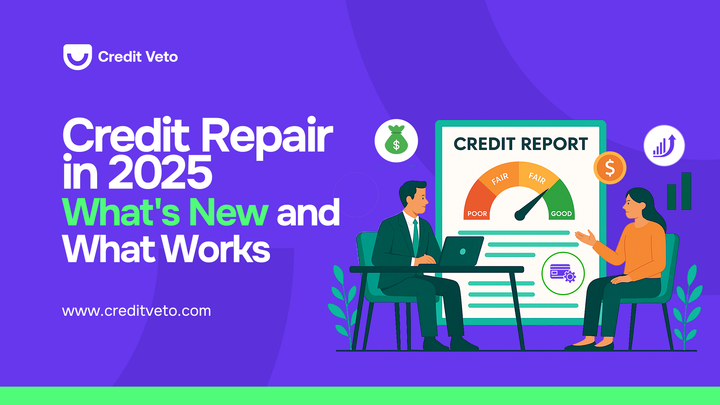How to Repair Your Credit Score in 30 Days (What Actually Works)
Think it’s impossible to fix your credit in just 30 days? Here are 8 steps that actually work to boost your score fast, from reducing debt to disputing errors legally.

Yes — it’s possible to see a noticeable improvement in your credit score within 30 days, but it depends on your current credit profile. If your credit score is suffering due to high credit utilization, outdated negatives, or errors, targeted action can trigger a quick jump.
However, there’s no “magic fix.” Fast credit repair works best when you understand how credit scores work and take the right steps, fast.
In this guide, we’ll show you what works, what doesn’t, and how to give your score the best possible lift in the next one month.
Why Credit Repair Matters (And Why Speed Helps)
According to FICO, the average American has a credit score between 670–739, but scores under 600 can severely limit access to loans, apartments, or even job offers. If you’re trying to rent, apply for a mortgage, or get approved for a credit card, your score matters.
Fast action can help you:
- Qualify for better interest rates
- Lower your insurance premiums
- Stop collection harassment
- Get approved faster for rental housing etc.
7 Proven Steps to Achieve Fast Credit Repair in 30 Days
Before you give up on your credit score or fall for unrealistic promises, take a breath because fast, legitimate credit repair is possible when you focus on the right actions. You don’t want to rush into taking the wrong steps.
Below are 7 practical, proven strategies that can help you raise your score within a month even if you’re starting from scratch or have recent dings on your report.
Again, these aren’t magic tricks. They’re real steps backed by credit laws and lender behavior that can help you build momentum fast.
Step 1: Check Your Credit Report for Free
Before you can fix anything, you need to know what’s hurting your score. The good news is that you can actually check your credit report for free. Start by doing these:
- Visit AnnualCreditReport.com. This is the official, government-approved site that gives you free access to your credit reports from the three major credit bureaus: Experian, Equifax, and TransUnion.
- You’re allowed one free report per bureau every 12 months, but during certain times (like the aftermath of COVID or due to federal updates), you might get more frequent access — so always check.
Once you’ve downloaded your reports, go through them with a fine-tooth comb. You’re looking for anything that seems off or outdated so take it seriously. Even small reporting mistakes can have a big impact on your credit score, sometimes dropping it by 50 to 100 points or more.
Here’s what to watch for:
- Accounts that don’t belong to you: These could be errors from people with similar names, or worse, signs of identity theft. Mixed files are very harmful to your score.
- Incorrect balances: If a credit card is showing a higher balance than you owe, it can increase your credit utilization, which makes up 30% of your score.
- Paid-off debts still showing as unpaid: If you’ve cleared an account but it’s still marked as delinquent, your score could be taking an unnecessary hit.
If you find any of these red flags, don’t wait — dispute them right away. You can do this directly through each bureau’s website or through tools like Credit Veto, which helps streamline the dispute process legally and efficiently.
The Fair Credit Reporting Act (FCRA) gives credit bureaus 30 days to investigate and respond to your dispute. That means cleaning up even a single item could help raise your score within a month making this step critical to fast credit repair.
Step 2: Pay Down Credit Card Balances
Your credit utilization ratio — how much of your credit you’re using — makes up 30% of your score. Using more than 30% of your credit limit signals risk, even if you’re making payments on time.
Here’s how to fix it quickly:
- Pay down your credit card balances as much as possible.
- Request a credit limit increase (make sure it doesn’t trigger a hard inquiry).
- Avoid new charges while you’re trying to repair your score.
Lowering your utilization can cause a noticeable score bump in just one billing cycle making this one of the fastest ways to improve your credit.
Step 3: Dispute Inaccurate or Negative Items
Old or incorrect negative items on your report could be dragging down your score unnecessarily. The good news? You have the legal right to dispute them and if they can’t be verified, they must be removed.
Here’s how to do it:
- Identify negative items like late payments, collections, or charge-offs that look questionable or outdated.
- File a dispute directly with the credit bureau — or use a platform like Credit Veto to generate dispute letters that comply with credit laws, automate and track the process.
- Include supporting documents if you have them (payment records, letters, etc.).
Under the FCRA, bureaus have 30 days to investigate and respond. If they can’t verify it? That negative item could be wiped from your report and your score could rise fast.
What You Can Dispute:
- Late payments (older than 7 years)
- Collections without verification
- Duplicate accounts
- Inaccurate personal information
Pro-Tip: Credit bureaus must respond within 30 days, so this is a perfect fast-track move.
Step 4: Become an Authorized User on Someone’s Card
If someone you trust, like a family member or close friend with a long-standing relationship, has a well-managed credit card, ask to be added as an authorized user. It’s one of the fastest credit-building hacks around.
Why it works:
- Their positive payment history and low credit utilization get added to your credit report.
- You don’t need to use the card — just being added can help boost your score.
This strategy works best when the account is old, has a low balance, and a perfect payment history. If done right, you could see a score increase in just a few weeks. It’s one of the fastest ways to add positive credit history without opening a new account.
Step 5: Use Credit-Boosting Tools
Some payments you’re already making — like rent, utilities, and phone bills — don’t normally count toward your credit score. But with tools like Experian Boost, you can change that.
How it helps:
- Adds positive payment history to your credit file.
- Can result in an instant score bump, especially if your file is thin.
It’s a simple, free tool that takes just minutes to set up and can make a real difference in your score fast
Step 6: Avoid New Credit Applications
When you apply for a new credit card or loan, it triggers a hard inquiry, which can temporarily lower your score — especially if you’re applying for several at once.
To stay on track:
- Hold off on any new credit applications during your 30-day credit repair sprint.
- Focus on managing your existing accounts well, that’s what makes the biggest difference short term.
Keeping your profile stable helps protect your score while you make other improvements.
Step 7: Set Up Auto-Pay to Avoid Late Payments
Just one late payment can cost you 90–110 points — even if it’s just an oversight. Payment history is the #1 factor in your credit score.
Avoid this with a simple fix:
- Set up auto-pay for at least the minimum amount due on each credit account.
- Use calendar reminders or budgeting apps to double-check due dates.
Consistently paying on time is the foundation of long-term credit health, and it keeps your progress from being undone by one missed bill.
Step 8: Monitor Your Credit Progress
Track your results weekly using tools like Credit Veto because credit monitoring is a must for building and improving your credit score.
Seeing your score move, even slightly, can keep you motivated — and help you catch issues early.
How Much Can My Score Improve in 30 Days?
While results vary, many users can see a 20–100 point increase within a month by:
- Lowering their utilization
- Disputing outdated negatives
- Fixing inaccurate data
- Adding new positive trade lines and following the steps listed above.
What Won’t Work in 30 Days?
- Building history from scratch
- Fixing defaults or charge-offs overnight
- Trying “credit sweep” scams — they don’t work and are illegal
The Bottom Line: Fast Credit Repair Is Possible With the Right Steps
While full credit recovery takes time, significant improvements can absolutely happen within a month — especially if your report contains fixable errors or high utilization.
The key is to focus on what’s in your control: accurate data, smart payments, and adding positive history.
Want Results in 5 Days? Join Our Free Credit Repair Challenge
At Credit Veto, we’ve helped hundreds of people like you improve their credit the smart and legal way and we want you to get started with our 5x5 Credit Fix Challenge:
- 5 Days of training
- 5 Core steps to repair your credit
- Learn how to earn by referring others
- No credit jargon — just real, legal strategies that work
Here’s what you’ll get in 5 days — absolutely free:
- Step-by-step business setup: From LLC to compliance, we walk you through it all.
- Done-for-you tools: Use built-in dispute templates, client tracking, and legal support inside the Credit Veto platform.
- Live client opportunities: Get matched with real clients — no cold outreach needed.
- Mentorship-ready certification: Complete the challenge and unlock advanced training, platform approval, and real credibility.
- Bonus: Enroll on Day 5 and get 6 months of Credit Veto Pro ($1,200+ value) — free.
No fluff. No fees. Just 5 days of clear, actionable steps to help you start earning by helping others repair their credit.
→ Reserve your spot now
FAQs: Fast Credit Repair
Q: How fast can I raise my credit score?
A: If you reduce your utilization and dispute inaccurate negatives, you could see results in 7–30 days, depending on when creditors update your file.
Q: Can I remove collections in 30 days?
A: Yes, if the debt is invalid or the collector can’t verify it under the FDCPA, you can force a removal.
Q: What score can I reach in 30 days?
A: You might gain 20–100 points, depending on your starting point and actions taken.
Q: Is credit repair legal?
A: Absolutely. Disputing inaccuracies and requesting validation under federal laws like the FCRA and FDCPA is your right.
Sign up now at Credit Veto today to start your FREE 5-day credit repair challenge. Cheers to your financial freedom.i




Comments ()